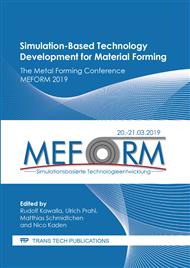[1]
R.H. Wagoner, H. Lim, M.-G. Lee, Advanced Issues in springback, Int. J. Plast. 45 (2013) 3-20.
Google Scholar
[2]
K. Richter, F. Reuther, R. Müller, D. Landgrebe, Investigating the Influence of Bending Parameters on the Springback Behavior of Ultra-High Strength Spring Strips, Mater. Sci. Forum 918 (2018) 125-133.
DOI: 10.4028/www.scientific.net/msf.918.125
Google Scholar
[3]
J. Mendiguren, F. Cortés, X. Gómez, L. Galdos, Elastic behaviour characterisation of TRIP 700 steel by means of loading-unloading tests, Mater. Sci. Eng. A 634 (2015) 147-152.
DOI: 10.1016/j.msea.2015.03.050
Google Scholar
[4]
R. Pérez, J.A. Benito, J.M. Prado, Study of the Inelastic Response of TRIP Steels after Plastic Deformation, ISIJ Int. 45 (2005), 12, 1925-1933.
DOI: 10.2355/isijinternational.45.1925
Google Scholar
[5]
S. Vitzhtum, M. Eder, C. Hartmann, W. Volk, Investigation on strain dependent elastic behavior for accurate springback analysis, J. Phys. Conf. Ser. 1063 (2018) 012118.
DOI: 10.1088/1742-6596/1063/1/012118
Google Scholar
[6]
DIN EN 10151, Stainless steel strip for springs – Technical delivery conditions, (2003).
Google Scholar
[7]
DIN EN ISO 6892-1, Metallic materials - Tensile testing - Part 1: Method of test at room temperature, (2017).
Google Scholar
[8]
F. Barlat, J.C. Brem, J.W. Yoon, K. Chung, R.E. Dick, S.H. Choi, F. Pourboghrat, E. Chu, D.J. Lege, Plane stress yield function for aluminium alloy sheets – Part 1: Theory, Int. J. Plast. 19 (2003) 297-319.
DOI: 10.1016/s0749-6419(02)00019-0
Google Scholar
[9]
C. Mertin, K. Huse, G. Hirt, Inverse modelling approach in 3-point bending for elasto-plastic material parameter identification of thin spring steel, J. Phys. Conf. Ser. 734/3 (2016), 032011.
DOI: 10.1088/1742-6596/734/3/032011
Google Scholar
[10]
M. Rosenschon, S. Suttner, M. Merklein, Validation of kinematic hardening parameters from different stress states and levels of plastic strain with the use of the cyclic bending test, Key Eng. Mater. 639 (2015) 385-392.
DOI: 10.4028/www.scientific.net/kem.639.385
Google Scholar
[11]
J. Franeck, Bestimmung elastisch-plastischer Materialparameter von Flugzeug-Aluminiumblechen unter niederzyklischen Zug-Druck-Beanspruchungen, PhD, Dresden (2014).
Google Scholar
[12]
W. Bleck, Y. Ma, X. Guo, The TRIP Effect and Its Application in Cold Formable Sheet Steels, Steel Res. Int. 88 (2017), 10, 1700218.
DOI: 10.1002/srin.201700218
Google Scholar
[13]
E. Doege, S. Kulp, C. Sunderkotter, Properties and application of TRIP‐steel in sheet metal forming, Steel. Res. 73 (2002) 303-308.
DOI: 10.1002/srin.200200213
Google Scholar
[14]
S. Thibaud, N. Boudeau, J. Gelin, Influence of initial and induced hardening in sheet metal forming, Int. J. Damage Mech. 13 (2002) 107-122.
DOI: 10.1177/1056789504039256
Google Scholar
[15]
L. Sun, R.H. Wagoner, Complex unloading behavior: Nature of the deformation and its consistent constitutive representation, Int. J. Plast. 27 (2011) 1126-1144.
DOI: 10.1016/j.ijplas.2010.12.003
Google Scholar


